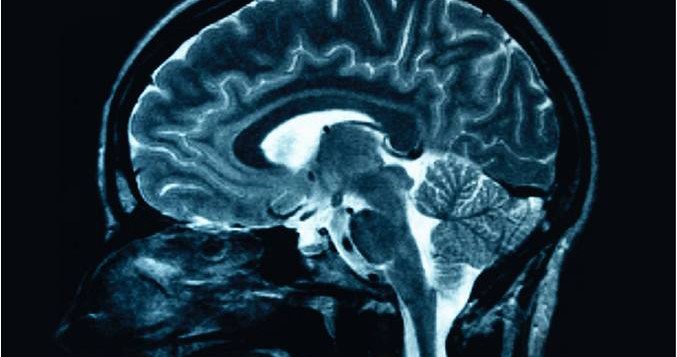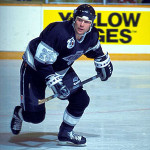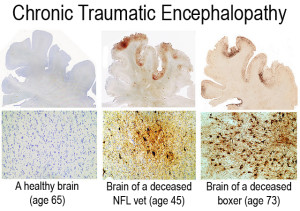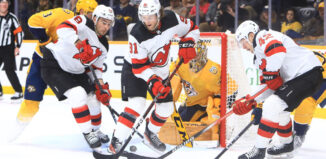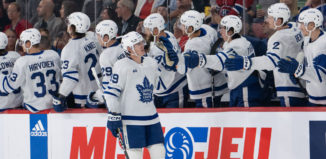Is Prevention Key to NHL Concussion Epidemic?
Photo: thehockeyfantatic.com
Concussion
noun
One simple online search for the word and an endless stream of pages flood the screen. As complicated as the structure of the brain itself, it seems as though there is no corner of the sports and healthcare world that concussions haven’t reached. From babies learning to crawl and bumping their heads, to professional athletes taking bone crunching hits, concussions have been center ice in the medical arena.
One role in particular has become a hot button topic each and every season amongst management, players, fans and medical professionals. Has fighting become the leading role to a lifetime of issues, and should it be removed from hockey?
Drafted 185th overall in the 1984 NHL Entry Draft by the Washington Capitals, former NHL enforcer, Jim Thomson lived a dream that many hockey players strive for. But behind the tough guy facade, Thomson was a player suffering through demons on a daily basis. Sleepless nights accompanied by drug and alcohol abuse and eventually depression became a familiar regime.
“I’m a very passive guy. I’ve never had a physical fight since I retired in 1995, its not like I walk around like this tough guy like I was in hockey. I hated fighting, I was a goal scorer that turned fighter and I hated it,” recalled Thomson. “I formed a drug addiction, depression and anxiety through this role, people don’t realize, I have to go into Chicago and fight Stu Grimson and Mike Peluso, I don’t sleep the night before, I have two bottles of wine and pop pills just to get through the fear. People don’t realize that. They show up to the game, waiting for Thomson and Grimson to line up against each other and they get their entertainment value – but prior to that I haven’t slept in two nights, because if I get knocked out, if I get my ass kicked, I’m going back to the minors. Was I worried about getting seriously injured? You never want to lose. I worried about losing and losing my job and that anxiety drove me nuts. I worked so hard to get to the NHL and now I’m one ass kicking away of my dream going away.”
The dream persevered, but not without consequence. Repeated blows to the head over the course of a professional hockey career has left Thomson with the memories, but also the lingering effects of concussions he once sustained.
“Eight documented [concussions] and how many more than that, I will never know,” said Thomson. “I had 124 pro fights, I played a rough style of hockey, 10 years, 3 years junior, so how much damage did I incur in my brain, I don’t know. Do I think about CTE, do I think about these guys that committed suicide? I think a lot about that.”
Never one to shy away from a brawl, on the ice or apparently in retirement, in 2011, Thomson chose to take a stand against the position that he built a career on. Making the bold statement that fighting needed to be taken out of hockey — and he took a beating for it.
“Roughly 5 years-ago, I came out publicly and said they needed to take fighting out of hockey because its killing the enforcer,” said Thomson. “What I meant by that is that a lot of my friends that committed suicide or died through tragic heart attacks or whatever, within the last decade have all been enforcers.”
Current and former enforcers hated him. Don Cherry publicly ripped him apart on Coaches Corner during Hockey Night in Canada, calling Thomson, Chris Nylan and Stu Grimson “pukes, turncoats and hypocrites,” but Thomson stood tall.
“Stu and Chris never said a word, it was me, they got dragged in innocently. We asked Don Cherry to apologize the following week on Hockey Night in Canada, he refused so we threatened to sue him, at the end of the day he apologized,” remembered Thomson. “So five or six years ago I publicly came out with my opinion and took a beating from current enforcers and from a lot of people in hockey like “how dare you, you made a living at it.”
The landscape of the game has changed, fighting is down and the role of enforcer is a dying breed. Where there is camaraderie as is such in any team environment, a player will always step in to defend a teammate, consequences be damned. While the NHL has made a conscious effort to change the game, Thomson argues that changes could still be made.
“The NHL has done a really good job in setting in rules, the fighting is way down. The only other change they can make is what I’ve been voting for, is if you fight in other sports, you get ejected. In hockey, you’re allowed to fight 3 times before you’re ejected,” said Thomson. “Even though fighting is down and there are only a couple of enforcers left, if you fight, you should be ejected from the game like other sports. You can never take fighting out of society, because two people get mad, they’re going to fight, verbal fight, or sometimes physical. I think the NHL has done a really great job in the last 5-6 years of putting in rules to eliminate this barbaric behavior. I am happy with where it’s going, but I’d still like to see the last step made of, if you fight, you’re ejected.”
Will that change ever come? Only time will tell, but as the concussion issue continues to force itself to center ice, players and leagues will need to make some tough decisions.
“As we find out more about concussions, CTE and head blows, I would say its probably time to take knuckles off the brain,” said Thomson.
Fighting in hockey is not the only way in which professional athletes succumb to concussions. The very nature of many sports combined with the speed and impact of athlete-on-athlete plays a major role, as well. The issue at hand does not only affect athletes at the professional level, but begins with our youth populations. According to the Centers for Disease Control, more than 248,000 youth under the age of 18 visited hospital emergency departments in 2009 for concussions and other traumatic brain injuries related to sports and recreation.
On the collegiate level, between the 2009-2010 and 2013-2014 academic years, the overall sport related concussion rate was 4.47 per 10,000 athlete exposures, or about 10,560 sports related concussions annually (NCAA Injury Surveillance Program).
Unfortunately, ice hockey, both men’s and women’s, dominated the NCAA’s concussion list, ranking below wrestling and above football.
Located at the University of Toronto, the Canadian Concussion Centre is doing their best to advance concussion research. The centre features various researchers in a variety of fields, neuropathology, neuroradiology, neurology, neurosurgery, psychiatry, etc., who share a common desire in understanding concussion and the concussion spectrum of disorders, ranging from acute concussion to the more prevalently recognized, in terms of athletes, Chronic Traumatic Encephalopathy (CTE).
Part of the team, neurosurgeon Charles Tator, MD, PhD, FRCPS, has become dedicated to researching concussions and bringing awareness not only through the Canadian Concussion Centre, but also Parachute Canada, a comprehensive injury prevention organization.
“I devote a considerable amount of time to prevention,” said Dr. Tator, “and I think the rationale is that at the present time, we really don’t have good treatments for many of the concussion spectrum of disorders, so it makes prevention the only cure that we have.”
In the states, CTE is most often used when discussing football players while in Canada hockey skates to the forefront.
“There’s no doubt that hockey is a significant cause of concussions. Of all the collision sports in Canada, hockey is number one as a cause of concussions,” lamented Dr. Tator. “Football isn’t as popular in Canada as it is in the US. In Canada, hockey is number one for causing concussions, of course, virtually every sport can cause concussions. Some sports that seem very innocent, they can all end up causing concussions, so, its good to be comprehensive. Hockey not only causes the initial part of the spectrum of concussion disorders like acute concussion, it also now is known to be one of the causes of CTE.”
In terms of professional sports, hockey is a small world, when tragedy strikes, it is not just felt by immediate family, but throughout the hockey community. As former players continue to shockingly take their own lives, the idea of prevention again comes into play. With a growing list of some of the NHL’s most beloved heavyweights; Derek Boogard, Rick Rypien, Steve Montador and most recently Todd Ewen leaving a skate print in the history books and on many hearts, are concussions to blame for their final decisions?
“We have examined a total of 21 brains and all but four were football players, so we’ve examined the brains of four hockey players and the last one we examined was Todd Ewen and he did not have it [CTE],” said Dr. Tator. “Previously we announced the results of Steve Montador who played for several NHL teams — and he definitely had it.”
Repeated hits, whether it be fighting or basic play, are all mitigating factors in the continued concussion and CTE story. The question still remains, how can we help players in life, before they decide that death is the only option.
“This is an evolving picture — but still, the significant rate limiting step is that it can only be diagnosed with certainty at autopsy,” said Dr. Tator. “We are looking at other strategies–the whole range of strategies–including neurological examination, neuropsychological assessment, blood biomarkers, PET scanning, as means of diagnosing this in life – because once we can diagnose it in life, then we will be able to answer questions like how common is it? And more importantly we may be able to do something about it. We might be able to start treating these people.”
For anyone who has suffered a concussion, large or small, the effects can be life changing. Anxiety, depression, headaches, dizziness, moods changes, fatigue, and many more symptoms plague patients. One hit could change a persons life and that thought is terrifying. The effects are felt by those suffering and trickle down to those around them as well.
“How distressing it can be — its really gripping the number of people who are suffering from postconcussion syndrome,” commented Dr. Tator. “People have a lot of symptoms and suffer greatly from this condition and sometimes it lasts for several years and sometimes forever.”
In an abstract from the Journal of the Canadian Chiropractic Association:
Concussions occur at all skill and age levels in ice hockey, and have been reported to account for 2–14% of all hockey injuries and 15–30% of all hockey head injuries. The large range of concussion incidence may be partially explained by the varied outcome measures used by researchers (i.e. athletic exposures vs. game hours vs. overall percentages). Unfortunately, the lack of a streamlined approach has made it difficult to draw conclusions and comparisons across studies.
And therein lies an issue, while the NHL has done its best at a comprehensive return-to-play protocol, it may just not be enough. Is it possible for a player to cheat the system? Maybe.
“The problem is that acute concussion is still a clinical diagnosis which means that it does require an experienced observer and it requires a compliant patient. If you don’t have both of those ingredients, the diagnosis can be hopeless,” said Dr. Tator. “So if the person doing the examination is not experienced its unreliable. If the person being examined wants to fudge it, or hide their symptoms which is often the case with teenagers who get concussions, then it’s very difficult to make the diagnosis. Obviously if someone is knocked out and they’re lying unconscious on the ice then its a concussion at least. But that only happens 5% of the time — so you really do need a compliant patient to make the diagnosis. We’re hoping that someday we’ll have more reliable tests for acute concussion, maybe even a blood test.”
A possible workaround to the compliancy issue, would be to have a second observer in the mix. While many youth or high school organizations may not have the funding for the additional protocol, collegiate and professional levels just might.
“We did look at the effect of a knowledgeable observer in a paper that we wrote a few years ago,” said Dr. Tator. “Where we found that in a junior hockey team, average age 18, that 25% of the team was concussed each season. That is a fairly reliable figure because we had trained knowledgeable observers at the rink making those determination – but if you don’t do that carefully, you can miss a lot of concussions.”
We know concussions happen, but how can society as a whole begin the protection process? Eliminating fighting, maybe. But changing the way we look at protection in sports could be the first piece to the evolving puzzle.
In December 2015, the National Football League (NFL), in conjunction with Under Armour, GE and the National Institute of Standards and Technology (NIST) announced their finalists for the Head Health Challenge III, an initiative that “seeks to stimulate the development of a range of materials that provide excellent energy absorbing and energy dissipating properties” (headhealthchallenge.com) in an effort to create new methods of protecting athletes from injury. But as a whole, the concept of the Head Health Challenge is so much more than that. The three sections of the challenge aim to bring awareness to the ever growing problem of injuries in athletes—the biggest and most concerning at present being that of concussions—and how to prevent them.
But the problem isn’t strictly confined to the 120-yard patch of turf, nor squarely on the NFL’s shoulders. The problem resonates throughout arenas and stadiums, in games played on turf and ice, across the world, but even finds itself within the boundaries of a picket fence where a friendly game is played among neighborhood children.
Based in an unassuming building in a small Maine town, Alba-Technic, LLC is quietly changing the game with their advanced shock absorbing polymers. Named one of the finalists in the Head Health Challenge III, the company is skating through a list of milestones, towards the final $500,000 prize, to be announced in the fall of 2016.
In terms of injury mitigation the energy absorbing honeycomb structure of Alba-Technic’s EVO2™ material may be the start to reducing injuries in sports. Originally designed as a headband, named SMARTY®, to help in falls protection for the elderly, the patented material can be utilized in many other applications.
“The healthcare industry has a tremendous amount of data on the amounts of falls and impacts to the head,” said Alba-Technic Founder and CEO, Jim Ferguson. “The consequences of a fall in the elderly are very visible because it’s significant to the family and the people involved. Sports related head injuries have tended to be underestimated in the damage that they can produce. Fortunately this is changing, we now see an increase and need for very advanced protective materials to be incorporated into safety equipment for sports events.”
The need for a better standard of protection is obvious. With ten plus pieces of equipment, one look into a players hockey bag begs the question; what can this technology be applied to? The obvious answer, the helmet.
“It would take some careful reworking of the design, manufacturing, and testing to make sure the designs behave as conceived,” said Vincent Caccese, Professor of Mechanical Engineering at the University of Maine. “I envision the advantages of EVO2 would result in significant improvements over most current helmet designs and could help to reduce concussions. That stated, the best way to remove concussions in hockey to the most extent possible is to reduce or eliminate the hits that cause concussion in the first place. I know that USA hockey and the NHL have processes and rules in place to do so, however, impacts to the head will still happen.”
At the end of the day, concussions will still happen, but the consequences may not lay as heavy on the heart if parents and athletes themselves are continually fed all the facts. Sports have become an ingrained part of society, and calling for an eradication of them is unlikely — therefore, finding new advanced methods of protection may soon become the best form of prevention.
Disclaimer: In conjunction with her position at The Pink Puck, Winter Adams also serves as a private public relations contractor for Alba-Technic, LLC.

